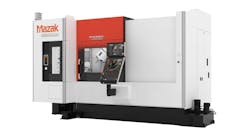Regardless of the complexity of the component, the developer noted that the main design benefit is that complex machining operations are possible simultaneously on the front and rear side — and thanks to two motorized milling spindles both operations are very productive.
Using HSK tools instead of live tool holders on turrets reduces tool costs, Index Corp. stated. The R300 is capable of hobbing or deep-hole drilling with single-lip tools and high-pressure coolant to 80 bar, to the tool edge through the motorized milling spindle. Grinding operations with a grinding point or an external grinding wheel up to 150 mm are available options, too.
With the addition of tool storage strips, the R300 is well equipped for 5-axis machining, on the main spindle with tool carrier 1 as well as on the counter spindle with tool carrier 2. With both linear tool carriers attached to each side of each milling spindle, the machinist can access six stationary tools per spindle with high precision. The developers have combined the functionality of a turret with a milling spindle, and this development means that tool changes are no longer necessary, thereby reducing the secondary processing time during turning. It also makes it easier to achieve precision fits.
Minimal setup, short secondary processing times — Index Corp. said operators can use the R300 to carry out full rear-end machining as well as parallel machining with identical sequences. Both heavy-duty roughing and fine turning can be conducted simultaneously on the main spindle and counter spindle. Up to 140 tools in the double-chain magazine ensure short setup times even for small batches, and tool change times (“chip-to-chip”) can be completed in the range of six seconds, according to the developer. In addition, there are 12 stationary tools on the tool strips of both milling spindles — 152 tools in total — available for an extensive range of functions. Each milling spindle can perform tool changes independent of the other, and HSK tool holders reduce the tool costs because live tool holders are no longer necessary.
To reduce personnel requirements, it’s possible to operate the R300 machine with a short bar loader, and an integrated workpiece handler is an option for handling heavy chucks.
Compact construction, travels — Because the design involves short lever arms and travels, Index Corp. noted, the system is very stiff and less susceptible to vibrations, which enhances the precision of the finished parts and prolongs tool life. High accelerations and rapid traverses are possible thanks to powerful drives and weight-optimized assemblies.
The two quill-guided motorized milling spindles are located in the center of the machine bed, and the axes are arranged so that conventional cross-slides with tool carriers are unnecessary. This arrangement, as well as the play-free and wear-free hydrostatic circular guide, promote machine stability. The 270-degree swivel of the B-axis and the 45-m/min. traverse rate promote flexibility and high-speed machining. Turning spindles with the same synchronous technology design have maximum power rating of 47 kW, a maximum speed of 3,500 rpm, and a peak torque of 690 Nm.
User-friendly controller, software — The Index control C200-4D SL is based on Siemens’ Sinumerik S840D digital NC series, with user-friendly enhancements by Index. Specially developed cycles simplify complex machining operations, support multi-axis milling and turning, and maximize functional reliability.
The Index VirtualLine software packages guide NC programmers and operators to optimal and appropriate machining steps, and with 3D simulation of the Index Virtual Machine programs can be created, verified, and optimized on the PC. The optional CNC Programming Studio provides advanced programming and operating support for the Index R300.
Energy efficiency — The Index R300 is built from weight-optimized components to reduce energy consumption and increase dynamic response. Energy recovery is achieved by regenerative drives and user-defined stand-by modes of units that consume large amounts of energy. Also, friction is minimized thanks to optimally paired materials and low-friction bearings (hydrostatic circular guide), and intelligent cooling principles support economical use of waste heat.
The Index cooling concept works to cool spindles, hydraulics, and the control cabinet constantly, and the heat can be used for service water heating or as process heat for other manufacturing via a “cold water interface.”
The new Index ECO fluid pump controller for cooling lubricant also reduces energy consumption. Its pressure- and consumption-dependent control for low- and high-pressure cooling lubricant volumes optimizes energy for the cooling lubricant supply. A frequency-controlled, permanent, and automatic adjustment of the pump speed ensures that only the volume of cooling lubricant that is consumed is transported.
The ECO fluid pump controller reduces the electric energy consumed, saving energy costs in high-volume (multi-shift) operations.






